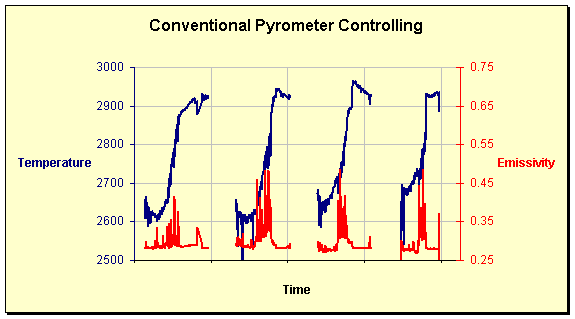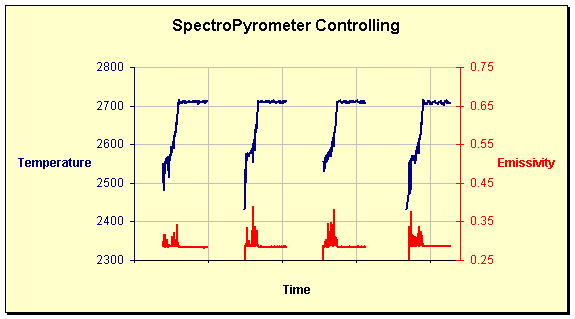Process Control
It stands to reason that the best measurement is a necessary ingredient for the best process control. The graphs reproduced below are from a metal casting process; the conditions differ only in the controlling pyrometer. Each graph shows both the temperature (blue) and emissivity (red) measured by a FAR SpectroPyrometer. Each contiguous cycle is one casting, so four consecutive castings are shown.

Conventional Pyrometer Controlling
The target was a liquid metal being heated electrically. The controlling instrument was a conventional brightness pyrometer; a SpectroPyrometer monitored and recorded the temperatures. Turbulence is known to enhance the emissivity of liquids. The spiky behavior of emissivity is the result of the controller turning the electrical power off and on. A spike in emissivity causes the conventional, controlling pyrometer to indicate that an over-temperature condition has been reached. The controller cuts power, allowing the melt to quiet and return to its baseline emissivity. The melt then registers as too cold and the power is turned back on, resulting in an electromagnetic pulse that induces turbulence, causing an emissivity spike. The process then repeats.
SpectroPyrometer Controlling
Contrast this behavior with that in the next graph when a SpectroPyrometer controls the process. The emissivity scale is the same, the temperature increments are the same, but the temperature range is lower. The reason for this is the process is now accurately achieving the setpoint temperature because of the accurate measurement of the SpectroPyrometer. Note that the temperature trace smoothly reaches the setpoint and controls closely about it until each cycle ends.

It is also evident that the spikiness, and therefore the turbulence of the melt, is greatly reduced. The repetitive power on-off sequence caused by turbulence has been removed. There is still some turbulence from electromagnetic stirring of the melt, which quiets completely when the setpoint is reached.
There are clear advantages to reduced turbulence, such as reduced erosion to sidewall refractories, and therefore reduced inclusions in the final product. However, turbulence may not be entirely a bad thing. What has been learned is that, within some limits, the turbulence can be controlled. It remains for the correlation with product quality to be done, and then for the process to be controlled to achieve optimum quality. What is also clear is that the data needed for the product quality correlation is now available.
